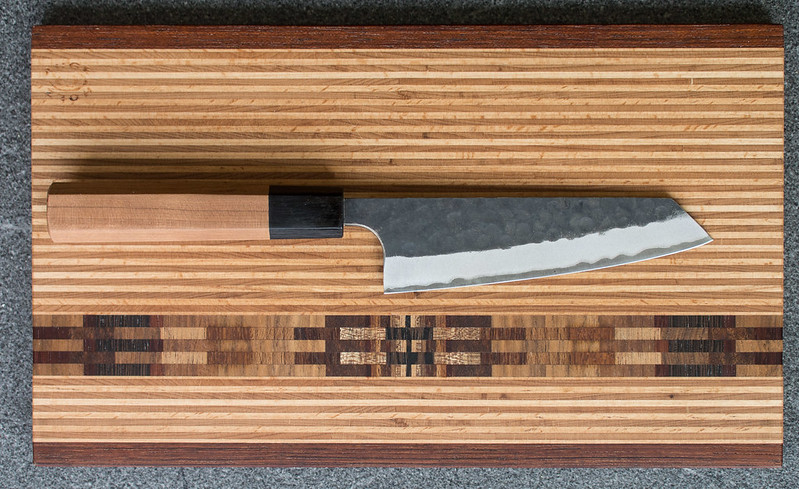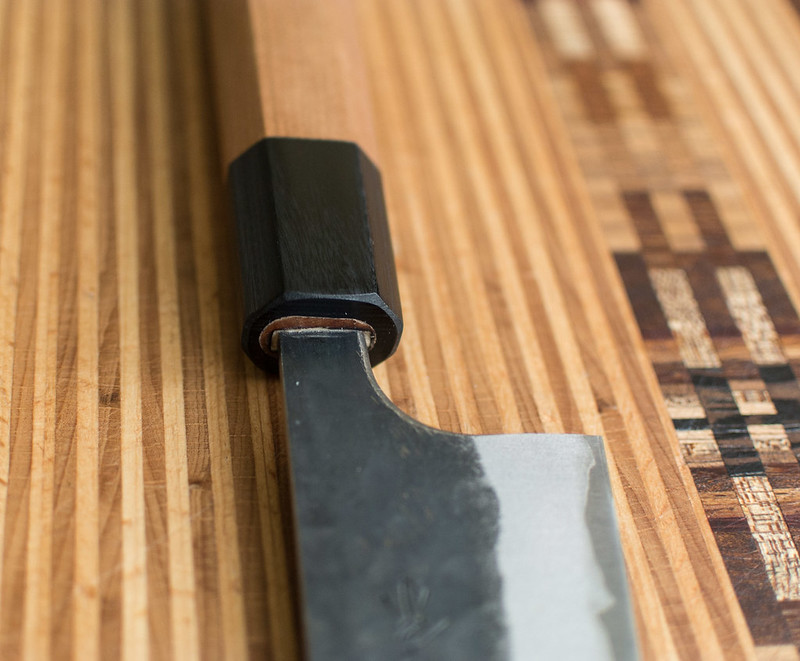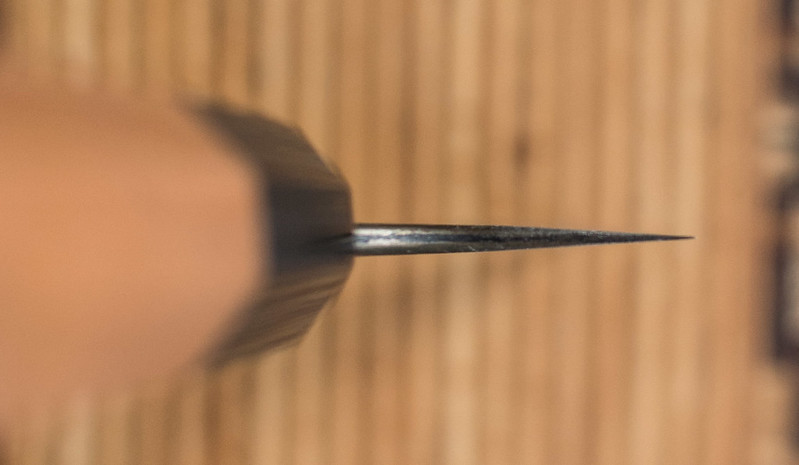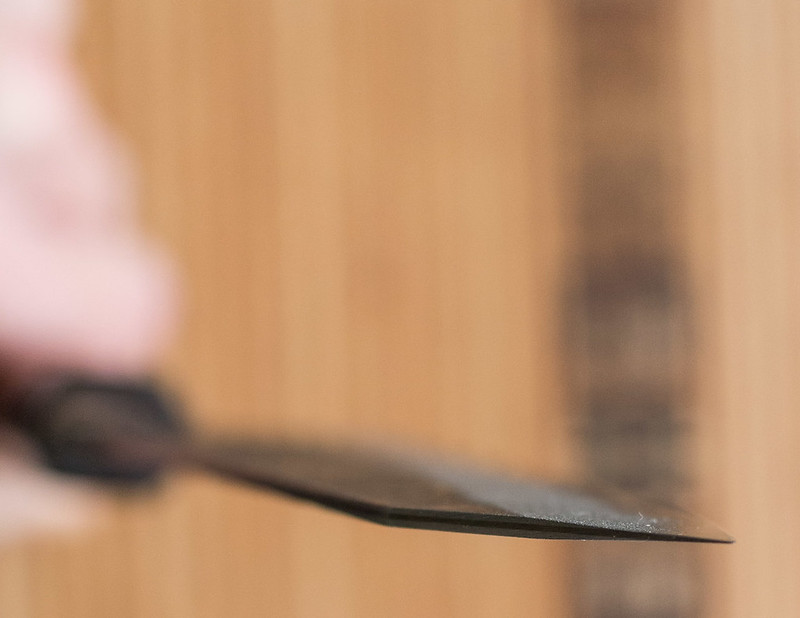Introduction:
As promised some time ago, here comes my review of the knife I bought a few months ago. I wanted to get some use out of the knife before I would go on with the review, including a sharpening session. Now that promise is to come true
The reason why I bought this knife was, that I was not very happy using 150mm petty as "serving knife" - meaning it is to be used with a small cutting board to cut cheese, salami, etc. directly on the dining table. I did not need a long blade, but I did need blade wide enough so that I would not hit the board with my knuckles every time I try to push-cut cheese. I was looking for a blade that would deliver that and finally found the bunka and ko-bunka knives that do exactly that.
How I got it:
I think it is fair to say that I have bought this knife from https://cuttingedgeknives.co.uk While their webpage and knife information is not as detailed as one is used to with EE, JNS or JKI, the contact with their stuff was very friendly and I was promptly provided with the information I have asked for. In short - the shopping was smooth and pleasant.
So, the knife:
Masakage Koishi line are AS (super blue steel) core clad with stainless with kurouchi finish. The handles are made from cherry wood (not stabilised) and the ferule is from black pakka wood.
Size/weight/shape:
- 72g
- blade (heel to tip): 130mm
- blade height at the heel: 37mm
- blade width (handle): 3.2mm
- blade width (heel): 2.5mm
- blade width (1/2 to tip): 1.6mm
- blade width (1cm from the tip): 1.2mm
Fit&Finish:
The kurouchi on the blade is very nice - I would be hard to guess that it is stainless - it looks very 'stable' - meaning I do not expect it to flake off over time. The transition from the kurouchi to the carbon cutting edge is matter (reminds sand blasted) stainless surface. The knife was delivered reasonably sharp with quite a distinct micro-bevel (which was more than necessary), but I used it that way for quite a while. The spine of the knife was polished. The edges of the spine are not rounded, but are not sharp either. The coil is completely rounded and has very comfortable shape.
The handle was very nice when the knife arrived, but first use of board butter got made the handle slightly rough so I want through 2 cycles of washing and polishing and now it is much nicer. The fit of the handle and the blade is clean.
In total - the knife was nicely finished, I did not find any relevant flaws.
How does it work:
The blade has a gentle curve - there is no flat spot so this knife is no 'petit-nakiri'. The blade is wide (tall) enough so there is enough room for your knuckles and the tip is pointy enough to be actually useful. I find the blade work very well for push-rock cutting (motion in which first the tip makes contact with the cutting board and than with a single rocking motion the heel. The 130mm blade is on the short side, but for the job intended it is completely sufficient. Since all the longer knives I have will soon be for sale and were taken off duty for that reason, I have also used this knife on other tasks for which it is not a perfect match (meet prep, salads prep) and I was surprised how good job it did in spite of the very short edge. That is simply the advantage of the taller blade.
The blade has quite particular cross section (see the coil and tip photos below) - it is thin behind the edge and then gets thicker at the point where the kurouchi starts. This is perfectly fine for this type of knife, but I would be concerned about wedging with a gyuto design. This is just a speculation - I can not confirm that myself. I would only like to stress that I find the blade design great for the tasks intended. The blade also has verily little flex - useful when slicing some harder food (had salami or cheese).
As I mentioned - the knife came with somewhat more pronounced micro bevel (the angle was too large). I took it to the stones yesterday (Gesshin 2000 and 6000). This is my first AS knife and I was surprised that it resisted sharpening more than I expected - no comparison to white #2 or even R2 (SG2) steel. While the Gesshin 2000 did not have any particular difficulty to set new secondary bevel (not visible in the photos below as these were taken prior to the sharpening) - which is still not particularly wide (some 1.5 or 2mm), I was surprised that with the Gesshin 6000 I need around 30 strokes on one spot to raise burr. Still - it was not hard to sharpen and removing burr was easy. The knife got perfectly shaving sharp and cuts pretty much incredibly.
Summary:
So far I really like the knife. It is my first experience with this type of design and I have to admit that I really like it. I am still considering getting a longer one (around 170mm) - ideally with a flat spot at the heel - for more veggie work. But I first need to get my hands on the Haburn gyuto that German customs still keep from me But back to the topic. The knife is well made, the steel can be made scary sharp. It sits well in hand and works great when there is not too much space. For me it is more practical than a petty of 120-150 mm length.
But back to the topic. The knife is well made, the steel can be made scary sharp. It sits well in hand and works great when there is not too much space. For me it is more practical than a petty of 120-150 mm length.
If you have any questions just ask
Now for the photos:
(click on the photos if you want access larger photos - although new Flick design makes it hard to access)




As promised some time ago, here comes my review of the knife I bought a few months ago. I wanted to get some use out of the knife before I would go on with the review, including a sharpening session. Now that promise is to come true
The reason why I bought this knife was, that I was not very happy using 150mm petty as "serving knife" - meaning it is to be used with a small cutting board to cut cheese, salami, etc. directly on the dining table. I did not need a long blade, but I did need blade wide enough so that I would not hit the board with my knuckles every time I try to push-cut cheese. I was looking for a blade that would deliver that and finally found the bunka and ko-bunka knives that do exactly that.
How I got it:
I think it is fair to say that I have bought this knife from https://cuttingedgeknives.co.uk While their webpage and knife information is not as detailed as one is used to with EE, JNS or JKI, the contact with their stuff was very friendly and I was promptly provided with the information I have asked for. In short - the shopping was smooth and pleasant.
So, the knife:
Masakage Koishi line are AS (super blue steel) core clad with stainless with kurouchi finish. The handles are made from cherry wood (not stabilised) and the ferule is from black pakka wood.
Size/weight/shape:
- 72g
- blade (heel to tip): 130mm
- blade height at the heel: 37mm
- blade width (handle): 3.2mm
- blade width (heel): 2.5mm
- blade width (1/2 to tip): 1.6mm
- blade width (1cm from the tip): 1.2mm
Fit&Finish:
The kurouchi on the blade is very nice - I would be hard to guess that it is stainless - it looks very 'stable' - meaning I do not expect it to flake off over time. The transition from the kurouchi to the carbon cutting edge is matter (reminds sand blasted) stainless surface. The knife was delivered reasonably sharp with quite a distinct micro-bevel (which was more than necessary), but I used it that way for quite a while. The spine of the knife was polished. The edges of the spine are not rounded, but are not sharp either. The coil is completely rounded and has very comfortable shape.
The handle was very nice when the knife arrived, but first use of board butter got made the handle slightly rough so I want through 2 cycles of washing and polishing and now it is much nicer. The fit of the handle and the blade is clean.
In total - the knife was nicely finished, I did not find any relevant flaws.
How does it work:
The blade has a gentle curve - there is no flat spot so this knife is no 'petit-nakiri'. The blade is wide (tall) enough so there is enough room for your knuckles and the tip is pointy enough to be actually useful. I find the blade work very well for push-rock cutting (motion in which first the tip makes contact with the cutting board and than with a single rocking motion the heel. The 130mm blade is on the short side, but for the job intended it is completely sufficient. Since all the longer knives I have will soon be for sale and were taken off duty for that reason, I have also used this knife on other tasks for which it is not a perfect match (meet prep, salads prep) and I was surprised how good job it did in spite of the very short edge. That is simply the advantage of the taller blade.
The blade has quite particular cross section (see the coil and tip photos below) - it is thin behind the edge and then gets thicker at the point where the kurouchi starts. This is perfectly fine for this type of knife, but I would be concerned about wedging with a gyuto design. This is just a speculation - I can not confirm that myself. I would only like to stress that I find the blade design great for the tasks intended. The blade also has verily little flex - useful when slicing some harder food (had salami or cheese).
As I mentioned - the knife came with somewhat more pronounced micro bevel (the angle was too large). I took it to the stones yesterday (Gesshin 2000 and 6000). This is my first AS knife and I was surprised that it resisted sharpening more than I expected - no comparison to white #2 or even R2 (SG2) steel. While the Gesshin 2000 did not have any particular difficulty to set new secondary bevel (not visible in the photos below as these were taken prior to the sharpening) - which is still not particularly wide (some 1.5 or 2mm), I was surprised that with the Gesshin 6000 I need around 30 strokes on one spot to raise burr. Still - it was not hard to sharpen and removing burr was easy. The knife got perfectly shaving sharp and cuts pretty much incredibly.
Summary:
So far I really like the knife. It is my first experience with this type of design and I have to admit that I really like it. I am still considering getting a longer one (around 170mm) - ideally with a flat spot at the heel - for more veggie work. But I first need to get my hands on the Haburn gyuto that German customs still keep from me
If you have any questions just ask
Now for the photos:
(click on the photos if you want access larger photos - although new Flick design makes it hard to access)








